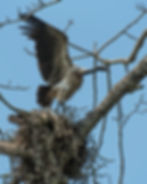The Status of Vultures in India: A Story of Decline and Recovery
- ecoNE
- Jan 30
- 3 min read
Updated: Mar 7
Text by Abhishek Srivastava
Photos by Udayan Borthakur

Vultures, once a common sight across India’s vast skies and landscapes, are now teetering on the edge of extinction. These scavengers play a critical role in maintaining ecological balance by feeding on animal carcasses, thereby preventing the spread of diseases. However, their populations have faced a catastrophic decline over the past few decades. Today, India’s vultures are slowly making a comeback, thanks to concerted conservation efforts, though significant challenges remain.
The Plummeting Population: A Crisis Unfolds
In the 1980s and early 1990s, India was home to millions of vultures, with several species thriving across diverse habitats. By the late 1990s, however, their numbers began to plummet dramatically. Within a decade, the populations of three vulture species—the White-rumped vulture (Gyps bengalensis), Indian vulture (Gyps indicus), and Slender-billed vulture (Gyps tenuirostris)—had declined by more than 95%. It was a wildlife crisis of unprecedented magnitude.
The primary cause of this sudden and alarming decline was the widespread use of the veterinary drug diclofenac, an anti-inflammatory given to livestock. When vultures fed on the carcasses of animals treated with diclofenac, they suffered from acute kidney failure, leading to their rapid demise. The drug, which was introduced in the early 1990s, had devastating unintended consequences for vulture populations, particularly in South Asia.
The Aftermath: Ecological and Cultural Impact
The collapse of vulture populations had wide-ranging ecological impacts. Vultures play a crucial role in disposing of dead animals, preventing the spread of infectious diseases such as anthrax and rabies. Without vultures, animal carcasses remained in the open for longer periods, leading to an increase in the number of scavengers like feral dogs and rats, which, in turn, increased the risk of disease transmission to humans.
Vultures also have deep cultural significance in India, particularly in the Parsi community, where they are an integral part of the sky burial tradition. With fewer vultures to consume human remains, this religious practice was disrupted, forcing changes in ancient cultural rites.
Conservation Efforts: A Ray of Hope
Realizing the severity of the situation, the Indian government, in collaboration with non-governmental organizations and conservationists, took decisive steps to save the remaining vulture populations. In 2006, the government banned the veterinary use of diclofenac, a landmark decision that has since been pivotal in vulture conservation.
Several vulture conservation breeding centers were established across India to breed and reintroduce vultures into the wild. Notable among these are the centers at Pinjore in Haryana, Rajabhatkhawa in West Bengal, and Rani in Assam. These centers have successfully bred vultures in captivity and released them into safe habitats.
Another crucial initiative is the Vulture Safe Zone (VSZ) program, where diclofenac-free areas are established, ensuring safe environments for vultures to thrive. These zones have been set up in states like Madhya Pradesh, Assam, and Uttar Pradesh. The program involves working closely with local communities, veterinarians, and cattle owners to promote the use of vulture-safe alternatives to diclofenac, such as meloxicam, which does not harm vultures.

Current Status and the Road Ahead
While the initial population decline was catastrophic, there has been a glimmer of hope in recent years. Populations of the three critically endangered species—White-rumped, Indian, and Slender-billed vultures—are stabilizing in some regions. Breeding programs have seen success, and the creation of vulture-safe zones has helped reduce the risk posed by toxic carcasses.
However, the road to full recovery is long. The illegal use of diclofenac, though banned, still poses a significant threat, as the drug is occasionally available in large-animal formulations intended for humans. Habitat destruction and declining food availability are additional challenges. Vultures are slow breeders, with long gestation periods and a low rate of reproduction, so even under the best conditions, it will take years for populations to fully recover.
Conclusion: A Delicate Balance
India’s vultures, though critically endangered, are symbols of resilience. The work of conservationists and government bodies has shown that, with the right actions, it is possible to halt and even reverse species decline. But continued vigilance is needed to safeguard these birds and the vital ecological services they provide. Vultures are not only scavengers—they are nature's cleanup crew, a keystone species in the web of life. Protecting them means protecting the health of our ecosystems and communities.
India stands at a crossroads in its efforts to bring vultures back from the brink of extinction. The future of these magnificent birds depends on sustained conservation, legal enforcement, and public awareness. With consistent effort, India can hope to see vultures once again soaring across its skies, restoring the balance they were always meant to keep.
About the Author :

Abhishek Srivastava is an independent researcher and currently studying the ecological behavior of Vultures in Pitthoragarh district of Uttarakhand- India.




